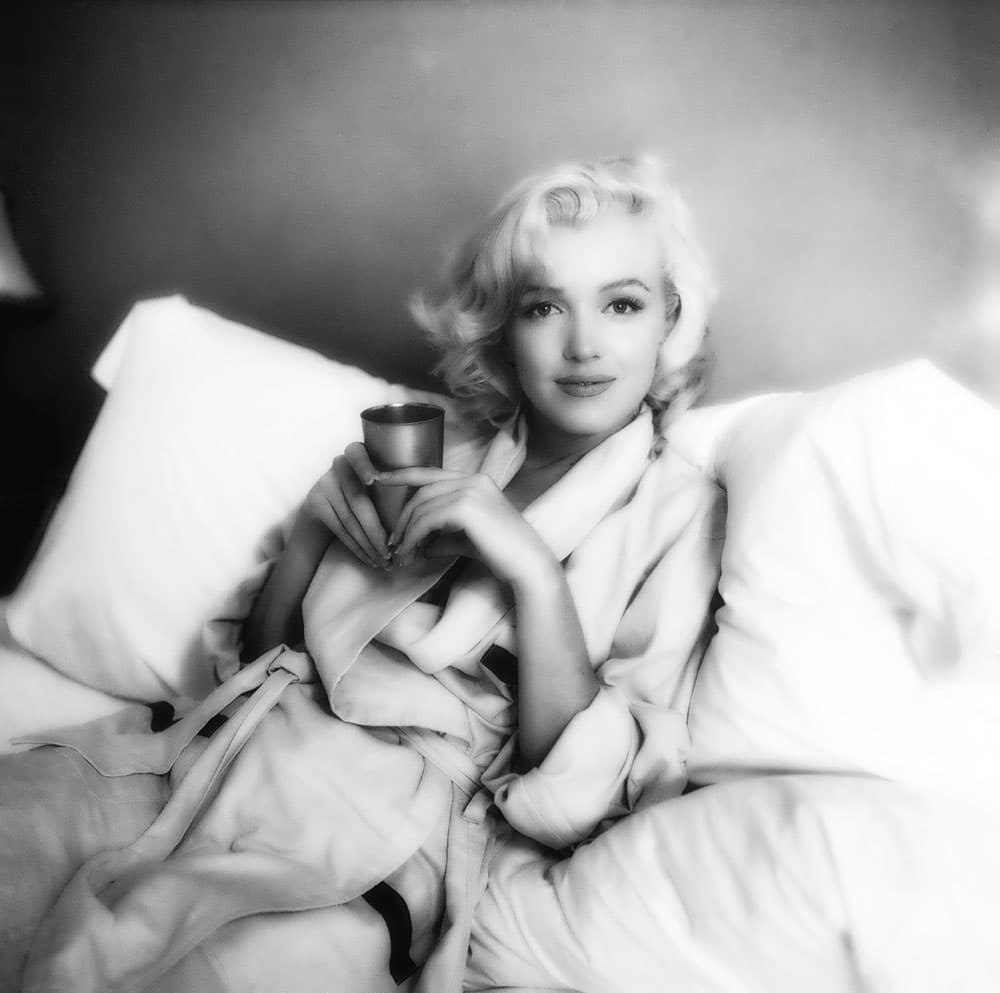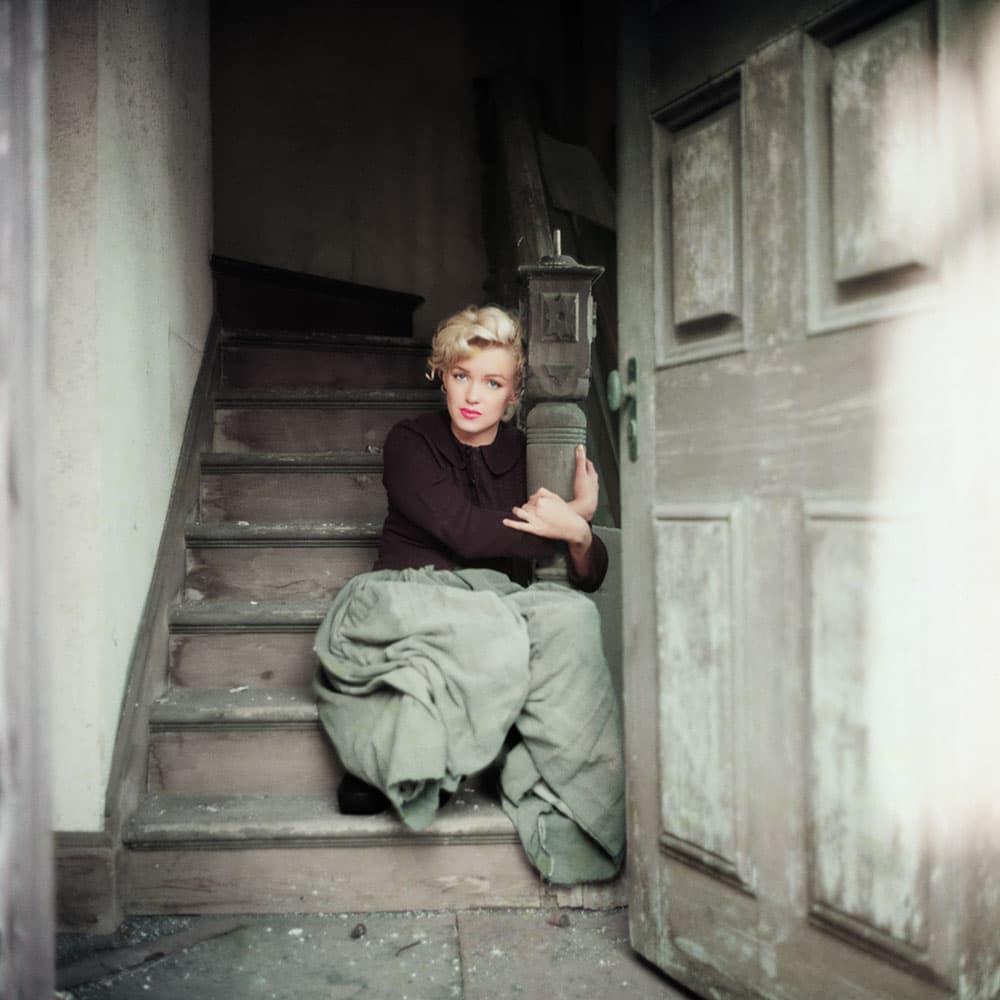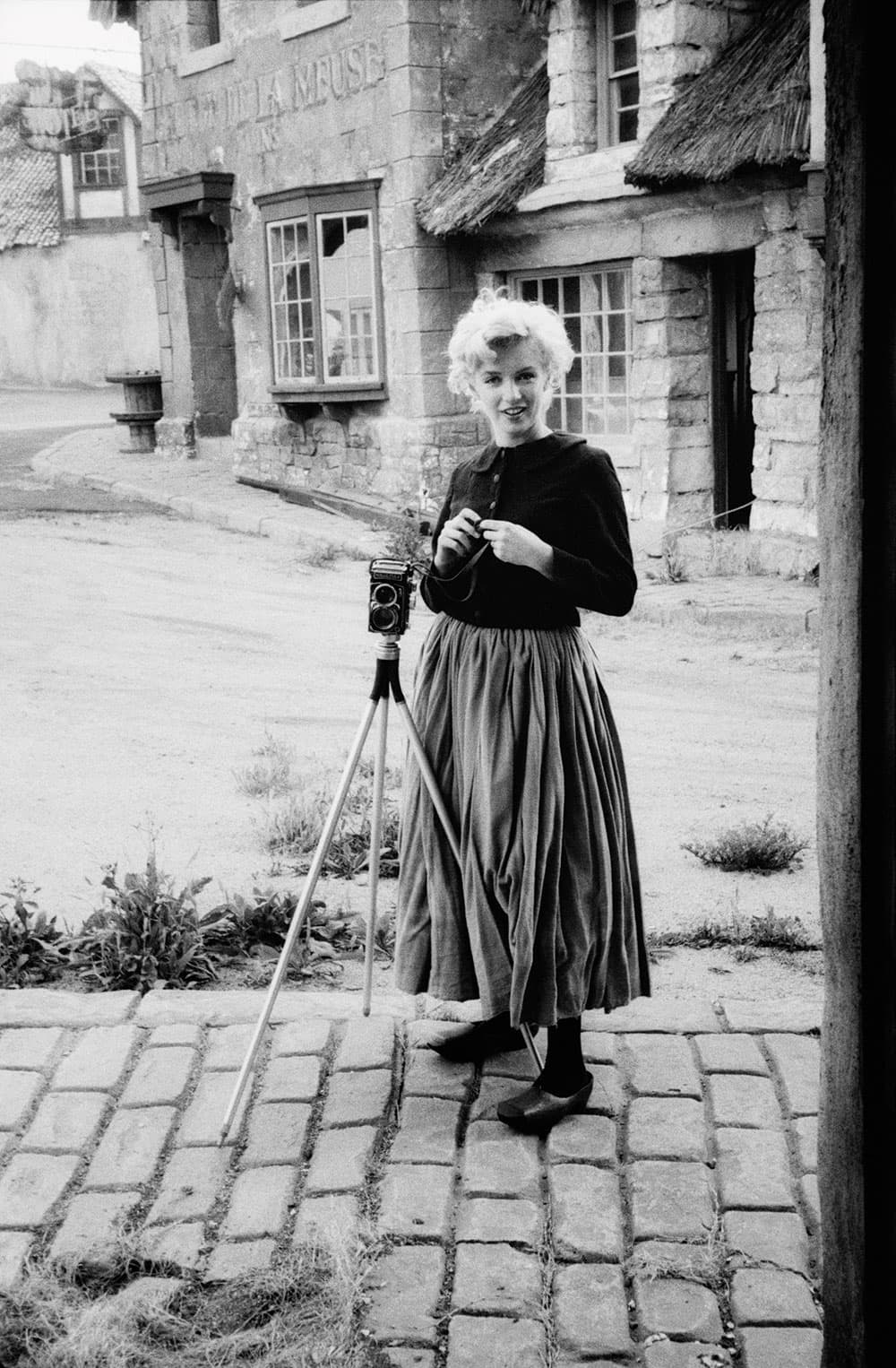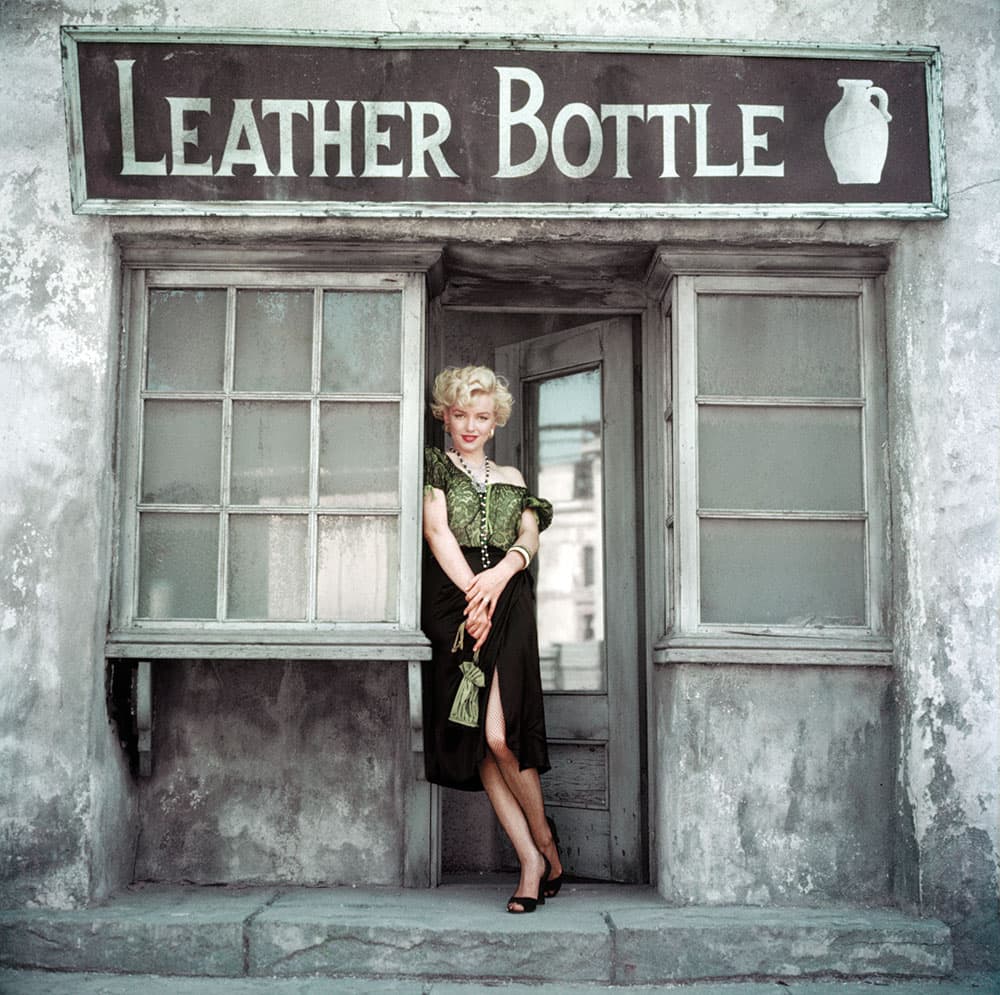More than half a century after her death, iconic images keep the silver-screen goddess Marilyn Monroe etched on the public’s consciousness. One of her closest collaborators was the fashion and celebrity photographer Milton H Greene, and 284 of his classic Monroe images – more than 150 of which are previously unseen – have been restored for the new book, The Essential Marilyn Monroe by Milton H Greene.
The man behind the project is one of Milton Green’s sons, Joshua, who has run a photography restoration business since the early 1990s. He reveals, ‘I grew up with cameras and photography all around me and he [Milton Greene] already had me printing in the darkroom at 11. He couldn’t trust any assistants any more because they were stealing [Marilyn] prints from him – there was a constant problem.’

A previously unpublished image from the ‘Bed Sitting’ shoot. Taken in a guest villa at the house of Joseph Schenck, 1953. Credit: Milton H Greene
He adds, ‘I was his assistant till I was about 18; then I had my own photographic career until about 1992. That’s when I had the vision and I started the archives. The primer was the fact that even though my dad was alive in the mid-’60s, we’d realised that so much of the colour film that he had shot in the 1940s and ’50s was very unstable and was fading – it was deteriorating to the point where you couldn’t reproduce it.’
Milton Greene passed away in 1985 and Joshua Greene says his father was, ‘sad over the fact that over 50% of his collection was faded and unusable due to time’. He continues, ‘All photography is finite, even black & white, so my point of view was “let’s start a company that restores photography”, not just my dad’s but anybody’s. I stopped taking pictures and focused on that.’

A previously unpublished restored image from the ‘Swimming Pool’ shoot at the house of Richard and Dorothy Rodgers,1955. Credit: Milton H Greene
Career changes
The book features restored images, many originally shot with just natural light, from 50 Greene and Monroe shoots that took place between September 1953 and January 1957.
Their collaboration came about because Monroe wanted to take control of her career, escape her 20th Century Fox contract, have director and script approval and be taken seriously as a character actress. Milton Greene had ambitions to become a movie producer and director so, as Joshua Greene puts it, ‘he basically bankrolled her departure from Hollywood and paid for her acting, singing and dancing lessons.’
For the Monroe photo sessions – which, to emphasise her versatility, were often designed to showcase her as a character – Milton Greene shot with a variety of equipment. This included 8x10in Deardorff and 4x5in Linhof cameras, both with Schneider lenses, a 21⁄4×21⁄4in Rolleiflex 2.8C TLR, and Canon and Nikon 35mm rangefinders.
Joshua Greene explains, ‘As good as this equipment was for its time all of those lenses were uncoated, meaning they didn’t refract light, and they lacked contrast and saturation. Worst of all was the Rolleiflex, which was the camera he used for over 70% of the library they created.’

A previously unpublished restored image from the ‘Peasant’ shoot, 1954. Credit: Milton H Greene
Total trust
The technical limitations of the 1950s photographic equipment were compensated for by Milton Greene’s approach and integrity. Joshua Greene reveals, ‘Milton’s gift as a photographer was that – as shy as he may have been at a dinner party – he was totally confident behind the camera. He was one of those people who didn’t shoot his way into a shoot; he waded in when it was time to take the picture.’
He adds, ‘In the case of most of the subjects, particularly Marilyn, if he shot two rolls of 12 exposure 21⁄4in [film] he could be done in an hour and a half. He was so old school that [it was a case of] “why take the shot if it’s not really happening yet? Wait for it.” That created another aspect of trust between the two of them that they could explore different things. Milton would never, ever show anybody a bad picture of his subjects. He would edit the film before it went out to a magazine or art director. They never got the shoot right from the lab.’
This respectful approach bore fruit for Milton Greene. ‘That really made the relationship between Milton and Marilyn exciting and strong; it allowed her to take risks that she may not have taken with other photographers,’ says Joshua Greene. ‘She proved to him that she really was a character actress by dressing up as caricatures. It was like two kids playing in a sandbox; they had a good time. Most of the shoots were for them; they weren’t on assignment.’

Marilyn posing with one of Milton H Greene’s cameras in a previously unpublished restored image from the ‘Peasant’ shoot,1954. Credit: Milton H Greene
The restoration process
According to Joshua Greene the new book was produced to satisfy the thirst of gallery owners and fans who longed to see the unseen Greene/Monroe pictures. He notes, ‘The flip side is those are some of the pictures that are in the worst condition, therefore taking the longest amount of time [to restore]. Over time, all of the films aged differently when kept in the same hostile environment. The 8x10in and 4x5in [films] were less affected than the 21⁄4in. The colour Kodachrome was, and remains, the most stable film Kodak produced.’
The restoration process was so intense that some of the images had up to 60 hours of work done on them. Of the 60 hours Joshua Greene estimates 40 went to ‘clean up’, 10 to make masks and 10 for his colour-management process.
He explains, ‘Depending on the image, we might do two or three high-res scans, capturing different white points and black points, so we got a greater amount of information within the digital footprint. Then we merged them together to have the best file to start with. The quality and condition was so bad that when you did a high-res scan you saw even more crap that you would never [previously] see. We did this at 200% and 300%. We were really looking at it [carefully] because I don’t want to go back and do it again!’

Marilyn in a previously unpublished restored image from the ‘Hooker’ shoot, 1956. Credit: Milton H Greene
Once the clean ups were done the team made multiple masks to identify every portion of the Monroe pictures – her eyes, lips, inside the mouth, hair, face, skin, arms, legs, individual pieces of clothing and individual elements in the background, such as skies or trees. This allowed Joshua Greene to go back in with different layers of colour management so he could control hues, values and saturation and then bring the colours back and blend them so they looked realistic.
He reveals, ‘It’s done with Photoshop. There’s some OnOne software I use and there’s some work with third-party effects that mimic what Milton used to do in the darkroom with diffusion… and there’s a lot of dodging and burning. I do it [colour work] in stages, but it’s spread out over time so I can let it breathe. You can’t go at it all at once. I like to go back to it so I’ll work on a couple at a time, then I’ll switch to a completely different sitting, so that I approach it fresh, and do a couple of those. With every picture I was pulling multiple prints to see how they looked; many times blown up to four times the size of the book so I could really see more detail in the digital work that was being done.’
Joshua Greene admits he isn’t happy with the earlier book, Milton’s Marilyn, in terms of the colour restoration work, which he says ‘really sucks’. He reveals, ‘The one thing that’s new about this book is I took it to another level and said, “If Milton was alive today how would he play with today’s technology?” There are [creative] liberties that photographers take and Milton did that and so, in this book, I did that. I didn’t want to f**k this one up; I wanted to get it right!’

Marilyn wearing her own clothes in a restored image from the ‘Tree’ shoot, 1953. Credit: Milton H Greene
Final thoughts
With the book published I ask Joshua Greene if anything surprised him about producing it. He replies, ‘I couldn’t get enough pictures in it! There are just under 4,000 pictures in the Monroe/Greene collaboration. Of those 4,000 probably 450 were candidates for “never-before-seen” and, of the 450, there are only 154 in the book. I still had to show some of the favourites that people expected to see in a book that’s the “last hurrah” to their collaboration. But I wanted the focus of it to be unpublished and unseen [images]. I felt that that was the “big gift” to photography, to the “Marilyn people” and to collectors.’
He says, ‘The book is a personal, inside look to my father as a photographer, celebrating the collaboration with Marilyn but with a keen focus on how good both of them were together. This was a true labour of love. It was something that I was fortunate enough to have a major role in but this was a joint effort and man, I’m very, very,very pleased.’

A young Joshua Greene pictured with Marilyn Monroe during a ‘Bus Stop’ shoot,1956. Credit: Milton H Greene
 The book The Essential Marilyn Monroe by Milton H. Greene (ACC Editions, ISBN: 978-1-85149-867- 3, £50) features the restored photographs of Marilyn Monroe, 154 of which have never been seen before, from 50 sessions of collaboration between Monroe and Greene. To find out more visit www.essentialmarilyn.com.
The book The Essential Marilyn Monroe by Milton H. Greene (ACC Editions, ISBN: 978-1-85149-867- 3, £50) features the restored photographs of Marilyn Monroe, 154 of which have never been seen before, from 50 sessions of collaboration between Monroe and Greene. To find out more visit www.essentialmarilyn.com.
 Born in 1922 in New York City, Milton H. Greene was a fashion and celebrity photographer, as well as a film and TV producer. He met Marilyn Monroe in 1953 and formed Marilyn Monroe Productions with her. Greene subsequently produced the Monroe movies Bus Stop and The Prince and the Showgirl. He died in August 1985, aged 63. His legacy is kept alive by one of his sons, Joshua, who runs a photographic restoration company.
Born in 1922 in New York City, Milton H. Greene was a fashion and celebrity photographer, as well as a film and TV producer. He met Marilyn Monroe in 1953 and formed Marilyn Monroe Productions with her. Greene subsequently produced the Monroe movies Bus Stop and The Prince and the Showgirl. He died in August 1985, aged 63. His legacy is kept alive by one of his sons, Joshua, who runs a photographic restoration company.







